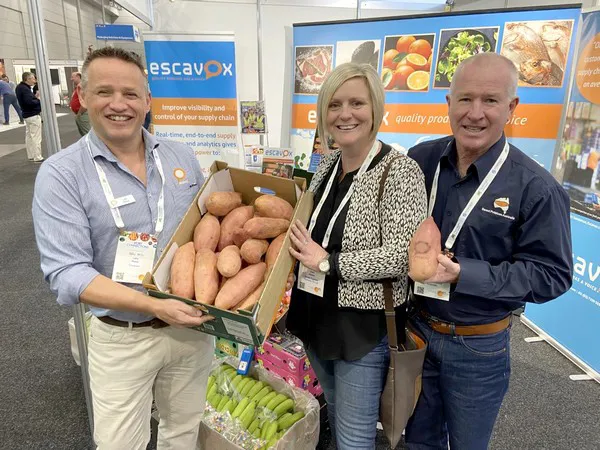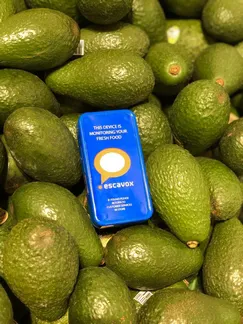An Australian supply chain data company is encouraging fresh produce suppliers to understand their supply chains better to seize opportunities for growth and increased profits while addressing issues that lead to food waste.
Escavox tracks fresh foods to provide visibility of the cold chain, making it easier to see the temperature and dwell time issues and allowing for corrective actions to be taken, therefore reducing rejections and loss. CEO Luke Wood said his company focused on brand protection, compliance and quality assurance as first priorities for customers, rather than directly tackling food waste.
"If your product sits on a shelf for too long due to poor quality then that is your brand and reputation on the line,” he said. “You don't have a waste issue; you have a brand protection and quality assurance issue. Focusing on quality, which means focusing on improving your supply chain, will resolve the waste problem. Central to this exercise is measuring and managing your supply chain with information that is captured independently and in real-time.”

Mr Wood says food waste could be broken down into three categories: produce that never leaves the farm; produce discarded in the supply chain and food disposed of in the household or industrial bin. He said 25 per cent of produce was lost to the supply chain due to poor control and handling after leaving the farm packing shed.
“Addressing this would help with the growing food insecurity problem as more fruit and vegetable products would be available for the end consumer,” he said.
Mr Wood said companies often found it hard to quantify the true cost of waste because they were not directly writing cheques for the loss, as they would for inputs and logistics.
"Escavox's advice is to look at it in terms of opportunity; if you improve operations, for example through the supply chain and cold storage processes, it will have a flow-on effect,” he said. "Waste is just the manifestation of the bigger problem you have. If you make your operations better, you get less waste, and you are spending less on other stuff. Once you can start measuring it, you can start unpacking what problems you do or don't have. First cab off the rank should be, what are you getting rejected and when - and by who and why? Is it temperature-related, or time-related? When you start measuring it you will find out where the waste is occurring. No one wants to throw anything away, and if we all throw away slightly less, we all do better. Producers also need to measure beyond their own farm, measure where it goes and what happens to it. Then they will understand what issues they have and what solutions they can employ."
The cost of fruit and vegetable 'food miles' on global emissions
This month, a study released in the journal Nature Food found that global food-miles emissions, in other words, the cost of transporting food for human consumption, are up to 7.5 times higher than previous estimates. Global freight transport associated with fruit and vegetable consumption contributes 36 per cent of food-miles emissions, almost twice the amount of greenhouse gases released during their production.
Mr Wood said there was often a “double impact” when transporting fruit and vegetables, with not only the emissions from the transportation fuel but also the refrigerant costs to preserve the freshness of the produce.
 "If we have tropical fruit grown in Cairns that needs to be sold in Melbourne, we are putting them on high speed, expensive, high-fuel burning transport to get down the east coast to meet tight timeframes,” he said. “If measuring our supply chains meant we were more confident in the stability of temperature, for example, we could do it slower, and protect the fruit slightly better and more efficiently in terms of cost, environment and waste. I am a huge fan of this research that is being done because it demonstrates that how product is handled 'in chain' is just as critical to emissions and energy costs as the distance travelled.”
"If we have tropical fruit grown in Cairns that needs to be sold in Melbourne, we are putting them on high speed, expensive, high-fuel burning transport to get down the east coast to meet tight timeframes,” he said. “If measuring our supply chains meant we were more confident in the stability of temperature, for example, we could do it slower, and protect the fruit slightly better and more efficiently in terms of cost, environment and waste. I am a huge fan of this research that is being done because it demonstrates that how product is handled 'in chain' is just as critical to emissions and energy costs as the distance travelled.”
The study also found that while long-distance trade plays an important role in providing access to nutritious food and mitigating food insecurity for vulnerable populations, it recommends one way of reducing food-miles emissions is to switch to locally produced food, so the fruit and vegetables do not have to travel as far.
Mr Wood said that was a good idea in theory but could be easier said than done when consumers had been conditioned to expect to produce year-round.
"We don't have an infrastructure or commercial network that supports that,” he said. “As an industry, we’ve barely even started to measure the efficiency of our supply chains using the real-time technology at our disposal. Trillions of dollars lost in the global food supply chain annually suggest we should be interrogating those potential savings in the supply chain much harder.”
For more information
Luke Wood
Escavox
Phone: +61 2 7209 3858
info@escavox.com
www.escavox.com
